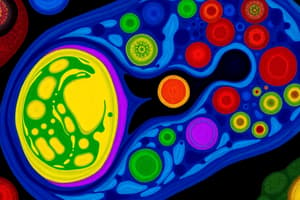Podcast
Questions and Answers
What is the initial source of gametes in embryos?
What is the initial source of gametes in embryos?
Primordial germ cells (PGCs) originate from the epiblast.
During which developmental process do germ cells migrate to the yolk sac wall?
During which developmental process do germ cells migrate to the yolk sac wall?
Germ cells migrate during gastrulation.
What are teratomas and what do they originate from?
What are teratomas and what do they originate from?
Teratomas are tumors that originate from pluripotent cells, which can differentiate into various tissue types.
What two main processes do germ cells undergo during gametogenesis?
What two main processes do germ cells undergo during gametogenesis?
When do primordial germ cells arrive at the developing gonads?
When do primordial germ cells arrive at the developing gonads?
What is the primary role of paracrine signaling in cellular communication?
What is the primary role of paracrine signaling in cellular communication?
What are the components involved in a paracrine signaling pathway?
What are the components involved in a paracrine signaling pathway?
How does a receptor typically function after a ligand binds to it?
How does a receptor typically function after a ligand binds to it?
What is the difference between paracrine and juxtacrine signaling?
What is the difference between paracrine and juxtacrine signaling?
What role do extracellular matrix ligands play in juxtacrine signaling?
What role do extracellular matrix ligands play in juxtacrine signaling?
Flashcards are hidden until you start studying
Study Notes
Germ Cells
- Fertilization combines male sperm and female oocyte to form a zygote.
- Primordial germ cells (PGCs) arise in the epiblast during the second week.
- PGCs migrate through the primitive streak into the yolk sac and then to the developing gonads by the end of the fifth week.
- Gametogenesis involves meiosis for chromosomal reduction and cytodifferentiation for maturation.
Clinical Correlations
- Teratomas are tumors from pluripotent cells differentiating into various tissues like bone and muscle.
- Pluripotent germ cells or mislocated PGCs could cause teratomas.
Cellular Signaling
- Essential for induction, competence, and intercellular communication.
- Paracrine Interactions: Involve proteins that diffuse to interact with other cells, utilizing diffusible proteins.
- Juxtacrine Interactions: Involve direct interactions between adjacent cells without diffusible proteins; utilize growth and differentiation factors (GDF).
Signal Transduction Pathways
- Paracrine signaling employs transduction pathways activating/blocking inhibitors (e.g., hedgehog signaling).
- Involves a signaling molecule (ligand) and a receptor spanning the cell membrane.
- Ligand binding activates the cytoplasmic domain of the receptor, typically a tyrosine kinase, leading to protein phosphorylation and a cascade of protein interactions which activate transcription factors influencing gene expression.
Mitosis Overview
- Mitosis produces two genetically identical daughter cells.
- Major phases include:
- Prophase: Chromosomes visible as distinct units.
- Prometaphase: Nuclear envelope breaks down, spindle fibers attach to centromeres.
- Anaphase: Sister chromatids separate and move to opposite poles.
- Telophase: Daughter chromosomes reach poles, spindle fibers disappear, nuclear envelopes reform.
Meiosis and Genetic Variability
- Crossing over during meiosis enhances genetic variability through chromatid exchange, leading to the formation of chiasmata.
- Meiosis results in haploid cells, restoring the diploid number upon fertilization.
- Polar bodies are byproducts of oocyte division and do not participate in fertilization.
Gametogenesis Processes
- Oogenesis: The process from oogonia to mature oocytes begins before birth.
- Spermatogenesis: Starts at puberty; spermatogonia develop into sperm in seminiferous tubules.
Chromosomal Characteristics
- Normal human somatic cells contain 46 chromosomes (diploid); gametes contain 23 chromosomes (haploid).
- Chromosomal abnormalities contribute significantly to congenital defects and spontaneous abortion, with about 50% of conceptions resulting in miscarriage due to such anomalies.
Maturation of Gametes
- In oogenesis, primary oocytes undergo divisions, resulting in a single mature oocyte.
- In spermatogenesis, four viable sperm are derived from each primary spermatocyte during meiotic divisions.
Studying That Suits You
Use AI to generate personalized quizzes and flashcards to suit your learning preferences.



